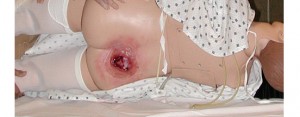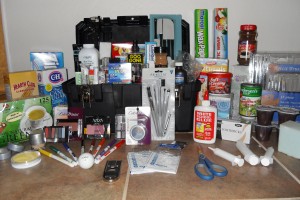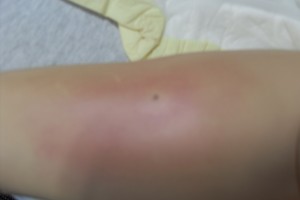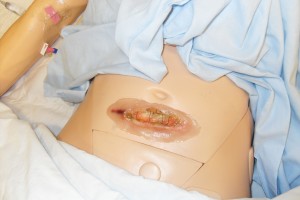This article was written by Guest Author Bobbie Merica
Bobbie Merica is a leading expert in the field of healthcare simulation moulage. As an accomplished simulation author, workshop educator and lab coordinator Bobbie is the definition of “simulation champion”. But now her latest work Medical Moulage: How to Make Your Simulations Come Alive has set the bar to a whole new level! Read our extensive review of her awesome book!
———-
When Healthcare Simulation exploded into the nursing education scene, it enabled educators to create medical experiences that rivaled what could be found in a clinical setting. For the first time, students were allowed to potentially make critical mistakes, (minus the ramifications of actually endangering a patient) enabling the student in gaining both experience and wisdom. All of this, while providing each student a realistic, patient-clinical interaction in a controlled setting. Nursing Schools/Hospitals/Clinical education sites excitedly got on board. Hundreds of thousands of dollars were spent acquiring equipment, building centers, learning extensive GUI programs, and writing time intensive cases. Educators excitedly lined up their students and waited expectantly …… only to discover the “Gap in Healthcare Simulation.”

(Stage 4 Decubitus Ulcer. All rights reserved.)
“What is real? How do you define real? If you are talking about what you can feel, what you can smell, what you can taste and see, then real is simply electrical signals interpreted by your brain.” – Morpheus in the Matrix
While the students thought the technology was certainly “cool,” we began to hear things like, “this doesn’t feel real, with a real patient I would never have done that,” or “I am not sure what I should pretend and what is supposed to be real..” Valid points, because if Nursing is anything, it is a sensory experience.
What is Moulage?
Moulage (French: casting/moulding) is the art of applying mock injuries for the purpose of training Emergency Response Teams and other medical and military personnel. Moulage may be as simple as applying pre-made rubber or latex “wounds” to a healthy “patient’s” limbs, chest, head, etc., or as complex as using complicated makeup and theatre techniques to provide elements of realism (such as blood, vomitus, open fractures, etc.) to the training simulation. The practice dates to at least the Renaissance, when wax figures were utilized for this purpose. It is also now common to use Moulage in order to train Military and Boy Scouts for shock desensitization.
-Wikipedia
(Image: Insect Bite. All rights reserved.)
Should I being using moulage in medical simulation?
Moulage is a tool that can be used to help the student look for the physical signs that support the stated diagnosis, recognize new finding and supports scenario learning objectives. When used appropriately in simulation, Moulage will increase knowledge and performance in the following areas:
- Increased response time
- Enhanced evaluation clues
- Supportive critical thinking
- Added realism
- Engage all the senses
- Suspends disbelief
Scenarios are designed to work with the physiology of the simulators, the addition of Moulage paints the sensory picture- providing the remaining clues that enable educators to “Bridge the Gap” TM between a clinical case and a simulated scenario.
Building the Moulage Kit
(Basic Moulage Kit . All rights reserved.)
. All rights reserved.)
What should be included in your medical simulation moulage kit?
- Here are a few items in ours:
- Tool Box
- Food Coloring
- Make-up
- Pearlescent shampoo
- Glycerin
- Foam Make-up Wedges
- Vaseline
- Cold cream
- Alka-seltzer
- Goggles
- Powdered Sugar
- Cornstarch
- Instant Chocolate pudding mix
- Band-Aids
- Condoms
- Tweezers
- Q-tips
- Colored markers
- Green tea bags
- Used coffee grounds
- Cinnamon
- Oatmeal packets
- Hot cocoa drink mix
- Baby oil
- Baby powder
- Latex glue
- Tissues; plain, white and thin
- Household Scissors
- Stipple sponge or brush
- Gallon freezer bags
- Saran Wrap
- Wax Paper
- Press n seal
- Toothpick
- Syringes various sizes
- Morning Breeze
- Golf ball
- 3X3 memory foam
- 6X6 egg-crate foam
- Bubble wrap, large
Some important things to consider before you begin your Picasso-
- All moulage make-up should be tested on a replaceable simulator neck skin piece prior to using on simulator. To test: Place make-up on skin piece for at least 1 hour before removing with GooGone. Remember: This is only ground breaking if it comes off!
- ALWAYS use a barrier unless it has been tested on a neck skin piece with positive results.
- DO NOT use any make-up that is advertised as a “long wearing” or “permanent” make-up without a hard barrier.
- Simulators consist of both hard and soft plastic skins (the replaceable pieces would be considered soft plastic.) The softer plastics will absorb more color.
- ALWAYS use a powder (cake) make-up; Never a cream based, liquid or spray on make-up. The one exception to this rule is the white (face) cream make-up.
- In a hurry? “Google” in any image, print, cut to size, apply hard barrier, and adhere to healthcare simulator.
- Most moulage can be cleaned up with soap and water; occasionally you might require something a little tougher like “GooGone”
- Halloween is also a fantastic time to pick up extras, especially the white cream make-up, plastic wounds and scars.
We understand you are busy; your allotment of set up time is around 5 minutes- 10 minutes, max! Clean-up needs to happen even faster. Therefore, we suggest you pre-create wounds/secretions/etc. in your down time and store appropriately. Doing so will enable you to pull together a realistic simulation in just a few minutes, saving you valuable time, yet providing your students a realistic medical simulation experience.
(Surgical Dehiscence. All rights reserved. )
For more great moulage tips and information check out www.moulageconcepts.com. Wishing you great success in your Moulage endeavors.
Bobbie Merica,
Author/Business Owner
Simulation Coordinator/Consultant
www.moulageconcepts.com
This article is referenced from Moulage-Bridging the Gap in Simulation TM, book on CD and is, unless otherwise stated, the property of Moulage Concepts. Copyright and other intellectual property laws protect these materials. Reproduction or retransmission of the materials, in whole or in part, in any manner, without the prior written consent of the copyright holder, is a violation of copyright law.
“What is real? How do you define real?If you are talking about what you can feel, what you can smell, what you can taste and see, then real is simply electrical signals interpreted by your brain.”
-Morpheus in the Matrix

Stage 4 Decubitus Ulcer
All rights reserved
Moulage- Bridging the Gap in Simulation TM
When Simulation exploded into the nursing education scene, it enabled educators to create medical experiences that rivaled what could be found in a clinical setting.For the first time, students were allowed to potentially make critical mistakes, (minus the ramifications of actually endangering a patient) enabling the student in gaining both experience and wisdom.All of this, while providing each student a realistic, patient-clinical interaction in a controlled setting.Nursing Schools/Hospitals/Clinical education sites excitedly got on board.Hundreds of thousands of dollars were spent acquiring equipment, building centers, learning extensive GUI programs, and writing time intensive cases.Educators excitedly lined up their students and waited expectedly………only to discover the “Gap in Simulation.” TM
While the students thought the technology was certainly “cool,” we began to hear things like, “this doesn’t feel real, with a real patient I would never have done that,” or “I am not sure what I should pretend and what is supposed to be real..”Valid points, because if Nursing is anything, it is a sensory experience.
What is Moulage?
Moulage (French: casting/moulding) is the art of applying mock injuries for the purpose of training Emergency Response Teams and other medical and military personnel. Moulage may be as simple as applying pre-made rubber or latex “wounds” to a healthy “patient’s” limbs, chest, head, etc., or as complex as using complicated makeup and theatre techniques to provide elements of realism (such as blood, vomitus, open fractures, etc.) to the training simulation. The practice dates to at least the Renaissance, when wax figures were utilized for this purpose. It is also now common to use Moulage in order to train Military and Boy Scouts for shock desensitization.
-Wikipedia
Bruise

Bruise 5-7 days
All rights reserved
Should I being using it?
Moulage is a tool that can be used to help the student look for the physical signs that support the stated diagnosis, recognize new finding and supports scenario learning objectives.When used appropriately in simulation, Moulage will increase knowledge and performance in the following areas:
·Increased response time
·Enhanced evaluation clues
·Supportive critical thinking
·Added realism
·Engage all the senses
·Suspends disbelief
Scenarios are designed to work with the physiology of the simulators, the addition of Moulage paints the sensory picture- providing the remaining clues that enable educators to “Bridge the Gap” TM between a clinical case and a simulated scenario.
Building the Moulage Kit

Basic Moulage Kit
All right reserved
What should be included in your moulage kit?Here are a few items in ours:
Tool Box
Food Coloring
Make-up
Pearlescent shampoo
Glycerin
Foam Make-up Wedges
Vaseline
Cold cream
Alka-seltzer
Goggles
Powdered Sugar
Cornstarch
Instant Chocolate pudding mix
Band-Aids
Condoms
Tweezers
Q-tips
Colored markers
Green tea bags
Used coffee grounds
Cinnamon
Oatmeal packets
Hot cocoa drink mix
Baby oil
Baby powder
Latex glue
Tissues; plain, white and thin
Household Scissors
Stipple sponge or brush
Gallon freezer bags
Saran Wrap
Wax Paper
Press n seal
Toothpick
Syringes various sizes
Morning Breeze
Golf ball
3X3 memory foam
6X6 egg-crate foam
Bubble wrap, large
Some important things to consider before you begin you Picasso-
·All moulage make-up should be tested on a replaceable simulator neck skin piece prior to using on simulator.To test:Place make-up on skin piece for at least 1 hour before removing with GooGone.Remember: This is only ground breaking if it comes off!
·ALWAYS use a barrier unless it has been tested on a neck skin piece with positive results.
·DO NOT use any make-up that is advertised as a “long wearing” or “permanent” make-up without a hard barrier.
·Simulators consist of both hard and soft plastic skins (the replaceable pieces would be considered soft plastic.)The softer plastics will absorb more color.
·ALWAYS use a powder (cake) make-up; Never a cream based, liquid or spray on make-up.The one exception to this rule is the white (face) cream make-up.
·In a hurry?“Google” in any image, print, cut to size, apply hard barrier, and adhere to simulator.
·Most moulage can be cleaned up with soap and water; occasionally you might require something a little tougher like “GooGone”
·Halloween is also a fantastic time to pick up extras, especially the white cream make-up, plastic wounds and scars.
We understand you are busy; your allotment of set up time is around 5 minutes- 10 minutes, max!Clean-up needs to happen even faster.Therefore, we suggest you pre-create wounds/secretions/etc. in your down time and store appropriately.Doing so will enable you to pull together a realistic simulation in just a few minutes, saving you valuable time, yet providing your students a realistic simulation experience.

Mottling
All rights reserved
Wishing you great success in your Moulage endeavors.
Moulage Concepts-
Bobbie Merica, Author/Business Owner
Simulation Coordinator/Consultant
Please stop by and say hello at www.moulageconcepts.com
This article is referenced from Moulage-Bridging the Gap in Simulation TM, book on CD and is, unless otherwise stated, the property of Moulage Concepts.Copyright and other intellectual property laws protect these materials. Reproduction or retransmission of the materials, in whole or in part, in any manner, without the prior written consent of the copyright holder, is a violation of copyright law.










